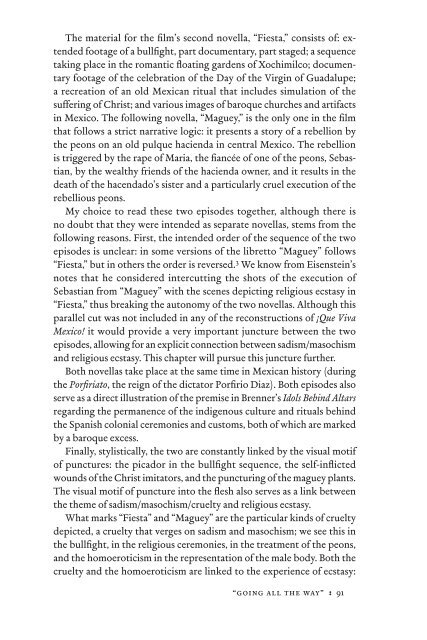In Excess: Sergei Eisentein's Mexico - Cineclub
In Excess: Sergei Eisentein's Mexico - Cineclub
In Excess: Sergei Eisentein's Mexico - Cineclub
Create successful ePaper yourself
Turn your PDF publications into a flip-book with our unique Google optimized e-Paper software.
The material for the fi lm’s second novella, “Fiesta,” consists of: extended<br />
footage of a bullfi ght, part documentary, part staged; a sequence<br />
taking place in the romantic fl oating gardens of Xochimilco; documentary<br />
footage of the celebration of the Day of the Virgin of Guadalupe;<br />
a recreation of an old Mexican ritual that includes simulation of the<br />
suffering of Christ; and various images of baroque churches and artifacts<br />
in <strong>Mexico</strong>. The following novella, “Maguey,” is the only one in the fi lm<br />
that follows a strict narrative logic: it presents a story of a rebellion by<br />
the peons on an old pulque hacienda in central <strong>Mexico</strong>. The rebellion<br />
is triggered by the rape of Maria, the fi ancée of one of the peons, Sebastian,<br />
by the wealthy friends of the hacienda owner, and it results in the<br />
death of the hacendado’s sister and a particularly cruel execution of the<br />
rebellious peons.<br />
My choice to read these two episodes together, although there is<br />
no doubt that they were intended as separate novellas, stems from the<br />
following reasons. First, the intended order of the sequence of the two<br />
episodes is unclear: in some versions of the libretto “Maguey” follows<br />
“Fiesta,” but in others the order is reversed. 3 We know from Eisenstein’s<br />
notes that he considered intercutting the shots of the execution of<br />
Sebastian from “Maguey” with the scenes depicting religious ecstasy in<br />
“Fiesta,” thus breaking the autonomy of the two novellas. Although this<br />
parallel cut was not included in any of the reconstructions of ¡Que Viva<br />
<strong>Mexico</strong>! it would provide a very important juncture between the two<br />
episodes, allowing for an explicit connection between sadism/masochism<br />
and religious ecstasy. This chapter will pursue this juncture further.<br />
Both novellas take place at the same time in Mexican history (during<br />
the Porfi riato, the reign of the dictator Porfi rio Diaz). Both episodes also<br />
serve as a direct illustration of the premise in Brenner’s Idols Behind Altars<br />
regarding the permanence of the indigenous culture and rituals behind<br />
the Spanish colonial ceremonies and customs, both of which are marked<br />
by a baroque excess.<br />
Finally, stylistically, the two are constantly linked by the visual motif<br />
of punctures: the picador in the bullfi ght sequence, the self-infl icted<br />
wounds of the Christ imitators, and the puncturing of the maguey plants.<br />
The visual motif of puncture into the fl esh also serves as a link between<br />
the theme of sadism/masochism/cruelty and religious ecstasy.<br />
What marks “Fiesta” and “Maguey” are the particular kinds of cruelty<br />
depicted, a cruelty that verges on sadism and masochism; we see this in<br />
the bullfi ght, in the religious ceremonies, in the treatment of the peons,<br />
and the homoeroticism in the representation of the male body. Both the<br />
cruelty and the homoeroticism are linked to the experience of ecstasy:<br />
“going all the way” : 91


